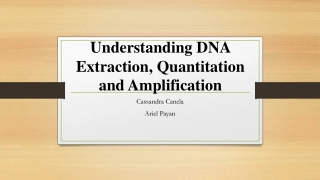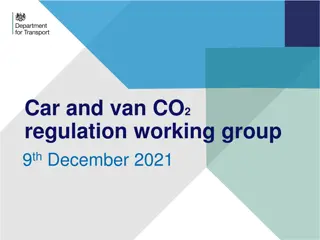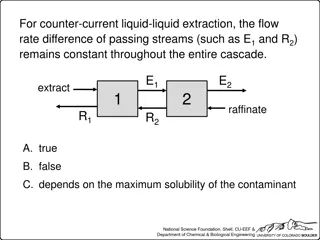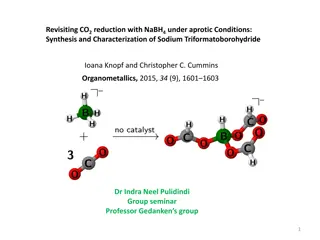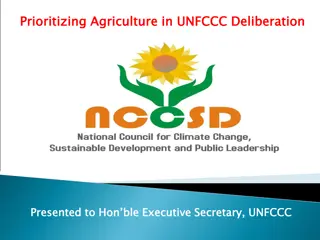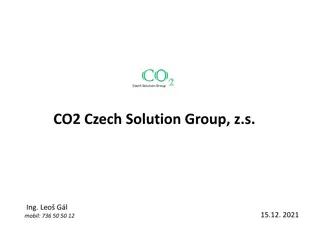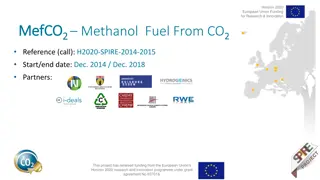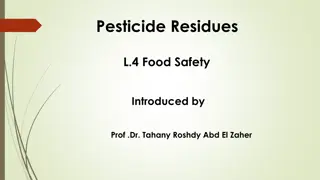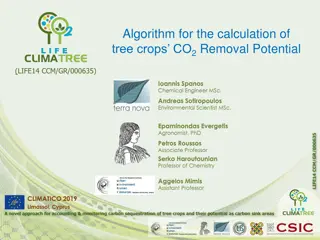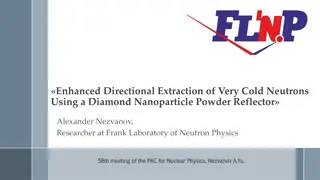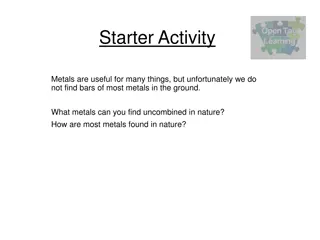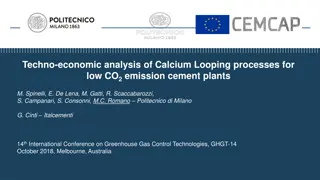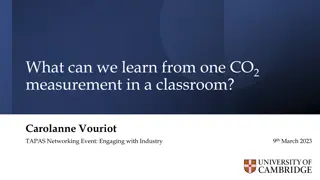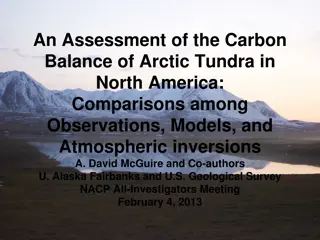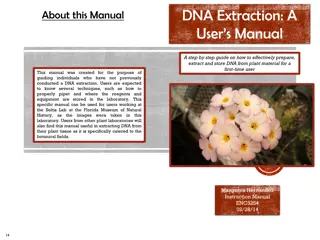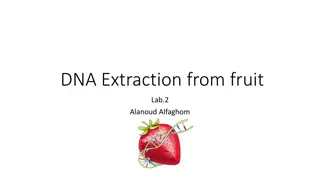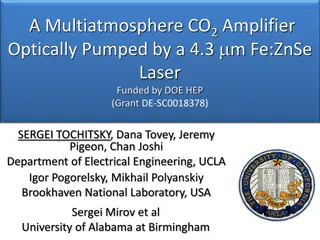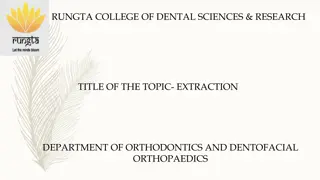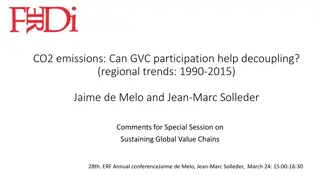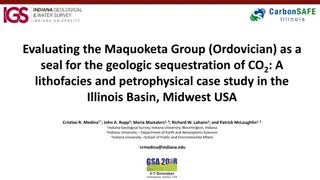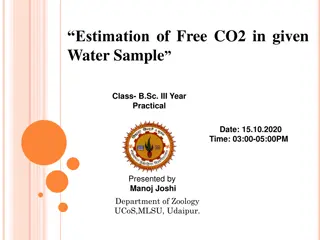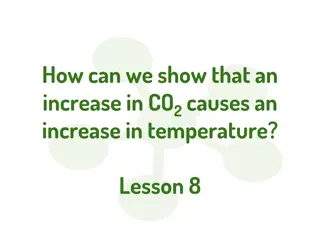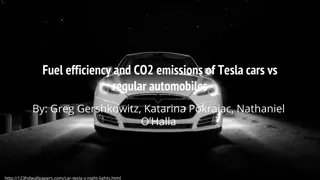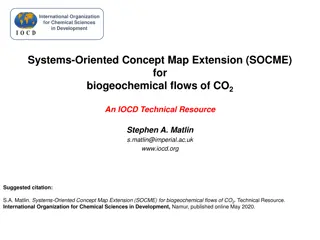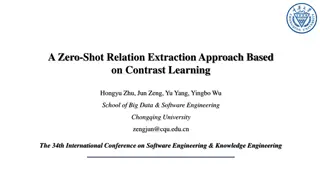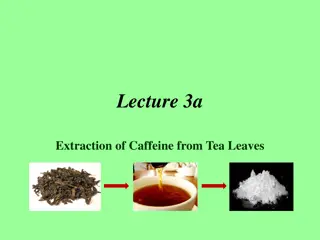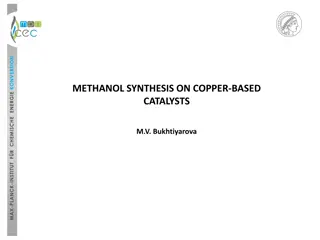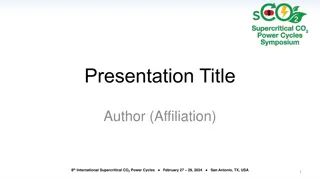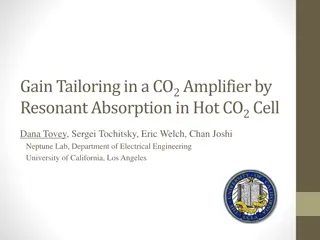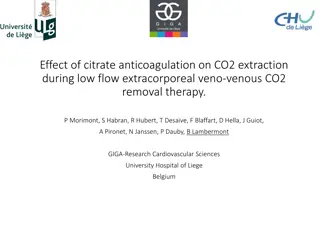Understanding DNA Extraction, Quantitation and Amplification
Learn the fundamentals of DNA extraction, including the two categories of extraction, potential issues, and how to determine the extraction category of your sample.
3 views • 40 slides
Revolutionary Lithium Extraction Technology by SORCIA/IBAT
SORCIA/IBAT's innovative lithium extraction process eliminates the need for chemicals, ensuring efficiency, resource protection, and cost-effectiveness. The modular and mobile plant design allows for rapid deployment with high flexibility, making it a game-changer in the industry. This breakthrough
0 views • 8 slides
Understanding Climate Change: Insights from Reed B. Haslam, NYSC Delegate 1972
Reed B. Haslam, an experienced atmospheric scientist, reflects on his early weather observations, noticing the impact of climate change through warming temperatures and reduced precipitation. He emphasizes the key contributors to global warming, such as deforestation and carbon dioxide emissions. Co
1 views • 54 slides
Developing the CAST Highlight CO2 Emission Estimator (Beta) - February 2024
CAST Research Labs studied the impact of removing green deficiencies detected by CAST Highlight on CO2 emissions and energy consumption in custom software applications. The study led to a formula for estimating potential CO2 emission reductions, which was integrated into the new CAST Highlight CO2 E
0 views • 11 slides
Understanding DNA Extraction from Strawberries in Molecular Genetics
In this molecular genetics lesson, students explore DNA extraction from strawberries. The content covers the structure of DNA, nucleotides, and the role of DNA in determining genetic information. Students learn about the components of nucleic acids, DNA functions, and the double helix structure of d
0 views • 87 slides
Overview of Car and Van CO2 Regulation Working Group Meeting, 9th December 2021
The Car and Van CO2 Regulation Working Group convened on 9th December 2021 to discuss recent and upcoming legislative changes impacting CO2 emission regulations for vehicles. The meeting included agenda items such as collecting on-board fuel consumption monitoring data, manufacturer requirements for
0 views • 28 slides
Liquid-Liquid Extraction Techniques and Considerations
Understanding liquid-liquid extraction processes like counter-current and co-current cascades, material balances, and system degrees of freedom. Topics include impact of flow rates, partition coefficients, solvent ratios, and purity on extraction efficiency.
0 views • 14 slides
Sodium Triformatoborohydride Formation via NaBH4-CO2 Reaction
Sodium triformatoborohydride, Na[HB(OCHO)3], is synthesized by reacting NaBH4 with CO2 under aprotic conditions. The choice of reductant is crucial for CO2 reduction methods, highlighting the role of NaBH4 as a cost-effective and reactive reducing agent for formate production. The exclusive formatio
1 views • 12 slides
Enhancing CO2 Absorption Through Prioritizing Agriculture in UNFCCC Deliberation
COP 24 aims to address the challenges of global warming but faces obstacles in reducing CO2/GHG emissions. Emphasizing agriculture as a key solution due to its CO2 absorption capabilities can lead to breakthroughs. Implementing measures like modern technology in agriculture and promoting initiatives
1 views • 12 slides
CO2 Czech Solution Group: Advancing Industrial Carbon Capture and Utilization
The .CO2 Czech Solution Group, led by Ing. Leo G.l.mobil, is focused on CO2 capture and utilization from industrial processes. They prioritize BioCCS, CCU technologies, and aim to establish expert groups, engage in international cooperation for a low-carbon economy, and create a cooperative environm
1 views • 17 slides
Horizon 2020 MefCO2 Methanol Fuel From CO2 Project Sustainability Impacts
The Horizon 2020 MefCO2 project focuses on producing methanol fuel from CO2, aiming to reduce CO2 emissions significantly and achieve renewable energy goals. The project aims to displace fossil fuels with green chemicals and advanced fuel production, providing solutions for energy storage and grid s
1 views • 6 slides
Extraction Methods in Pesticide Residue Analysis for Food Safety
Extraction methods play a crucial role in separating pesticide residues from food matrices for analysis. Techniques involve using solvents to efficiently remove pesticides without causing chemical changes. The choice of extraction method depends on the substrate type, with liquid and solid substrate
6 views • 25 slides
Algorithm for Tree Crops CO2 Removal Potential
Algorithm for the Calculation of Tree Crops CO2 Removal Potential (LIFE14.CCM/GR/000635) focuses on efficiently determining the capacity of tree crops to remove CO2 from the atmosphere. This algorithm considers various factors such as the biological cycle of the tree, cultivation practices, and carb
1 views • 17 slides
Slow Extraction Operations at Fermilab Main Injector
Overview of slow extraction operations at Fermilab Main Injector, covering beam transport, low to medium energy user test beams, Drell-Yan experimental beam, and spill procedures. Details on beam targets, production, and observation of high-energy positrons. Also, insights on spill regulation techni
0 views • 12 slides
Enhanced Directional Extraction of Very Cold Neutrons Using Diamond Nanoparticle Reflector
Alexander Nezvanov, a researcher at Frank Laboratory of Neutron Physics, presented a study on enhanced directional extraction of very cold neutrons using a diamond nanoparticle powder reflector. Very cold neutrons (VCN) have unique properties making them ideal for various applications in neutron tec
0 views • 11 slides
International Workshop on Offshore CO2 Storage: Goals, Expectations, Logistics
The International Workshop held in Texas aimed to foster collaboration and knowledge sharing on offshore CO2 storage. Topics included understanding requirements, sharing best practices, and identifying challenges and opportunities for offshore storage. The event highlighted the global potential for
1 views • 18 slides
Validation Study of Rapeseed Oil Body Extraction Methods
This study explores the validation of two rapeseed oil body extraction methods. It delves into the common uses of rapeseed, the components of oil bodies, and their potential applications in the human food system. The materials and methods section details the extraction processes, including dry and w
2 views • 23 slides
Metal Extraction: Processes and Applications
Metals play a crucial role in various industries, but their extraction from ores is a complex process. Some metals occur naturally in an uncombined form, indicating their low reactivity. Through heat alone, unreactive metals like lead can be separated from their ores. This extraction process involve
2 views • 16 slides
Techno-Economic Analysis of Calcium Looping Processes for Low CO2 Emission Cement Plants
This study explores the application of Calcium Looping (CaL) processes in cement plants to reduce CO2 emissions. The process involves using CaO as a sorbent to capture CO2 from flue gas, with the potential for integration at different points in the cement production process. The Tail-end CaL configu
3 views • 14 slides
Insights from CO2 Measurement in Classroom Ventilation
Understand the significance of CO2 measurements in classroom ventilation for better indoor air quality and reduced infection risks. Explore the use of CO2 sensors, data analysis, and proxy models to improve ventilation systems in schools. Discover findings on airborne infection risk and variations w
2 views • 9 slides
Carbon Balance of Arctic Tundra in North America: An Overview
This assessment delves into the carbon balance of Arctic tundra in North America, comparing observations, models, and atmospheric inversions. Co-authored by researchers from various institutions, the study analyzes data from 1960 onwards, addressing the changing CO2 sink in high latitudes. It evalua
0 views • 17 slides
DNA Extraction: A User's Manual for Plant Material
A step-by-step guide on preparing, extracting, and storing DNA from plant material for first-time users, specifically tailored for individuals in botanical fields. The manual covers materials needed, CTAB buffer mixture preparation, leaf material preparation, DNA extraction process, and proper stora
0 views • 8 slides
DNA Extraction from Fruit Lab: Strawberry Extraction Method
Explore the fascinating process of breaking cell barriers and extracting DNA from strawberry cells. This comprehensive lab guide provides detailed instructions on how to extract DNA using simple materials like strawberries, plastic bags, ethanol, liquid detergent, and more. From mashing the fruit to
1 views • 11 slides
Multiatmosphere CO2 Laser Amplification Funded by Department of Energy
A project funded by DOE HEP focuses on developing a multiatmosphere CO2 amplifier optically pumped by a 4.3m Fe:ZnSe laser. The motivation lies in exploring the potential of optically pumped CO2 lasers for generating picosecond pulses at a high repetition rate. The project involves a collaboration b
0 views • 11 slides
Extraction in Orthodontics and Dentofacial Orthopedics: Comprehensive Overview
Painless extraction of teeth is crucial in orthodontic treatment for achieving normal occlusion and creating space in the dental arch. Historical background traces the evolution of extraction in orthodontics. The need for extraction is determined by factors like arch length-tooth material ratio, int
0 views • 38 slides
CO2-Laser-Driven Dielectric Laser Accelerator Proposal
Study and experimental demonstration of a CO2-laser-driven dielectric laser accelerator, addressing the limitations of current accelerator technologies by utilizing longer laser wavelengths for increased charge and improved beam control. The proposal aims to develop a novel in-vacuo scheme for ultra
0 views • 13 slides
CO2 Emissions and Global Value Chains: Trends in Decoupling and Regional Impacts
The discussion focuses on the relationship between CO2 emissions and Global Value Chains (GVCs) from 1990 to 2015, exploring how GVC participation can aid in decoupling. It covers the environmental implications of GVCs, such as the effects on CO2 footprints, trade patterns, and emission intensities
0 views • 19 slides
Evaluating Maquoketa Group for CO2 Sequestration in Illinois Basin
Study examines the Ordovician Maquoketa Group's potential as a seal for CO2 geologic sequestration in the Illinois Basin. The project background, methodology, results, and conclusions highlight the importance of the CarbonSAFE Initiative in developing storage sites for carbon dioxide from industrial
0 views • 20 slides
Estimation of Free CO2 in Water Sample for B.Sc. III Year Practical
The practical session focuses on estimating free CO2 in a water sample using titration methods with NaOH and Na2CO3. Students learn the process of converting carbonic acid to neutral sodium bicarbonate to determine the presence of free CO2. Procedures, reagents, observations, and calculations are de
0 views • 6 slides
Exploring the Relationship Between CO2 and Temperature Increase
This lesson guides students through an investigation to show the correlation between CO2 levels and rising temperatures. The students design a model using water bottles, thermometers, and Alka-Seltzer to test if CO2 can cause a temperature increase. They analyze data and draw conclusions to understa
0 views • 9 slides
Comparing Fuel Efficiency and CO2 Emissions of Tesla Cars and Regular Automobiles
Explore the fuel efficiency and CO2 emissions of Tesla cars versus regular automobiles through the innovative technology of electric motors. Tesla cars boast equivalent fuel efficiency of 87 miles per gallon, up to 265 miles on a single battery charge, and significantly lower CO2 emissions. The elec
0 views • 9 slides
Systems-Oriented Concept Map Extension for Biogeochemical Flows of CO2
The Systems-Oriented Concept Map Extension (SOCME) explores the biogeochemical flows of CO2, detailing interactions within the ocean and land subsystems, including factors such as uptake by different biomes, anthropogenic CO2 generation, deforestation effects, and energy production contributions. It
0 views • 6 slides
Zero-Shot Relation Extraction Based on Contrast Learning
This paper presents a zero-shot relation extraction approach based on contrast learning, aiming to improve the efficiency of relation extraction tasks. The methodology involves utilizing a knowledge graph to extract relational triplets and leveraging zero-shot learning to automate the process. The s
0 views • 21 slides
Electrochemical Reduction of CO2 on Copper and Mixed Metal Oxides
Different methods for CO2 reduction have been studied, with electrochemical reduction showing promise due to its use of electricity from nonconventional sources. Research on copper's unique characteristics for producing various CO2 reduction products has led to investigations into optimizing activit
0 views • 30 slides
Understanding Caffeine Extraction from Tea Leaves
Caffeine, a widely consumed alkaloid, is extracted from tea leaves using organic chemistry techniques. This process involves liquid-liquid extraction to isolate the caffeine from the mixture of substances. The efficiency of extraction relies on the solubility of the target compound in a chosen solve
0 views • 17 slides
Methanol Synthesis on Copper-Based Catalysts at Max Planck Institut
Methanol production using synthesis gas, studying CO2 hydrogenation for reduced CO2 emissions, and utilizing methanol as a hydrogen storage method are key areas of focus at the Max Planck Institut for Chemical Energy Conversion. The process involves methanol synthesis from CO2 and H2, with experimen
0 views • 19 slides
Utilizing Hydrotalcites as Photo Catalysts for Carbon Dioxide Reduction
Burning fossil fuels leads to CO2 emissions, posing a significant environmental challenge. Converting CO2 into valuable hydrocarbons through photocatalytic reduction using solar energy provides a sustainable solution. This process involves multi-electron transfer steps, requiring efficient catalysts
0 views • 24 slides
8th International Supercritical CO2 Power Cycles Conference in San Antonio, TX, USA
The 8th International Supercritical CO2 Power Cycles Conference is scheduled from February 27-29, 2024, in San Antonio, Texas, USA. This conference aims to bring together experts in the field to discuss the latest advancements and research in supercritical CO2 power cycles. The event will feature pr
0 views • 9 slides
Optimizing Gain Tailoring in CO2 Amplifiers for Laser Applications
The research focuses on enhancing gain tailoring in a CO2 amplifier through resonant absorption in hot CO2 cells, crucial for applications such as generating light channels in air, particle acceleration, and laser fusion. The study involves amplification of short pulses, CO2 laser gain spectra analy
0 views • 9 slides
Effect of Citrate Anticoagulation on CO2 Extraction in Low Flow Extracorporeal Venovenous CO2 Removal Therapy
This study evaluates the impact of citrate anticoagulation on CO2 extraction during low flow extracorporeal veno-venous CO2 removal therapy. The experiment conducted on a pig model comparing citrate anticoagulation to standard heparin protocol showed a trend towards improved CO2 extraction with citr
0 views • 6 slides
